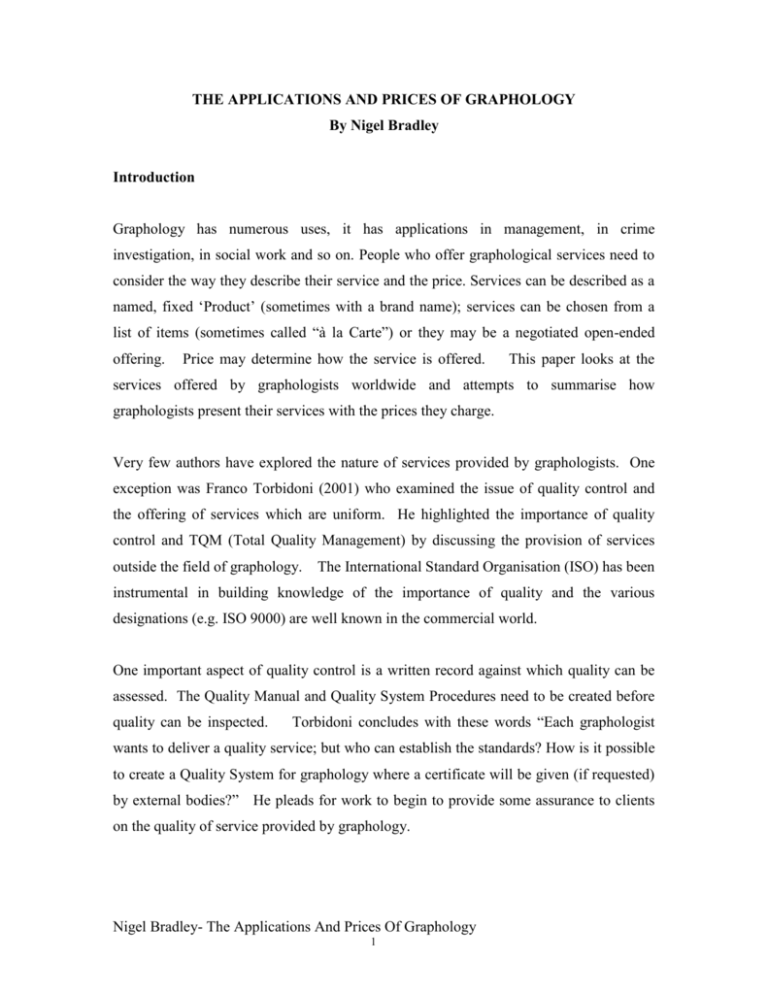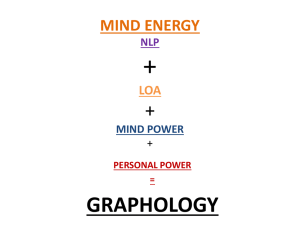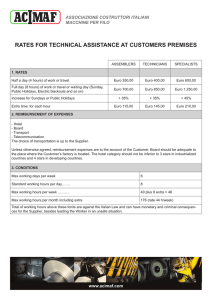Document
advertisement

THE APPLICATIONS AND PRICES OF GRAPHOLOGY By Nigel Bradley Introduction Graphology has numerous uses, it has applications in management, in crime investigation, in social work and so on. People who offer graphological services need to consider the way they describe their service and the price. Services can be described as a named, fixed ‘Product’ (sometimes with a brand name); services can be chosen from a list of items (sometimes called “à la Carte”) or they may be a negotiated open-ended offering. Price may determine how the service is offered. This paper looks at the services offered by graphologists worldwide and attempts to summarise how graphologists present their services with the prices they charge. Very few authors have explored the nature of services provided by graphologists. One exception was Franco Torbidoni (2001) who examined the issue of quality control and the offering of services which are uniform. He highlighted the importance of quality control and TQM (Total Quality Management) by discussing the provision of services outside the field of graphology. The International Standard Organisation (ISO) has been instrumental in building knowledge of the importance of quality and the various designations (e.g. ISO 9000) are well known in the commercial world. One important aspect of quality control is a written record against which quality can be assessed. The Quality Manual and Quality System Procedures need to be created before quality can be inspected. Torbidoni concludes with these words “Each graphologist wants to deliver a quality service; but who can establish the standards? How is it possible to create a Quality System for graphology where a certificate will be given (if requested) by external bodies?” He pleads for work to begin to provide some assurance to clients on the quality of service provided by graphology. Nigel Bradley- The Applications And Prices Of Graphology 1 Aims of this study This study takes Franco Torbidoni’s work further. It focuses on an issue that should be part of any Quality Control Manual, it is a description of services provided. Price is also explored in some detail although it must be stated that it is unlikely to be part of a quality control manual. Price is important because it is a large determinant of how different services are described. The objective of this study is to describe the different services offered by graphologists. A sub-objective is to attempt to attach a price to each of these services. Methodology There are many ways to earn money from graphology so some services have been kept outside the scope of this enquiry. The excluded services are as follows: public speaking; teaching; sale of distance learning materials; sale of books, videotapes, CDs, flashcards etc.; teaching penmanship; remedial writing therapy; calligraphy-related skills. It should also be remembered that there are many ways to be paid other than ‘cash’. This can include royalties, retainers, shares, success-only-fee, bonuses, commissions, in kind etc. Such complications have largely been avoided in this article. This study is based almost entirely on a search of secondary data. It draws on books, articles, promotional literature and web sites of practising graphologists. Graphologists describe their services in many different ways and a useful way to create an overall description is to look to professional bodies. Two French professional groupings are particularly helpful in this respect; they are the GGCF and the SGDS. Both organisations have web sites with lists of their members and their specialisations; immediately we have an indication of the most common services offered. Such material is extensive, a simple internet search on the words ‘graphology’ with ‘prices’ showed that over 700 pages include both terms, in English alone. The major challenge was to reduce this documentation in a meaningful way. Relevant literature was identified and inspected, looking for common or conflicting themes. Finally practitioners were contacted Nigel Bradley- The Applications And Prices Of Graphology 2 informally to add more understanding to the synthesis. Sometimes prices are not published, but are available on request, therefore this assistance was important. Hundreds of pages of printouts of web pages dated 1999, 2000, 2001 and 2002 were inspected and the published prices for 55 graphologists from many different countries were located. These sites were revisited in July 2002 and the information was updated and collated. Only 8 graphologists gave a price per hour most prices were attached to services. In many cases several prices were given, so up to three prices were noted for each supplier, which led to the recording of 117 price points. Prices were rounded up/down to the nearest currency unit. If postage/delivery or reports was described and priced apart from services, it was added to the price. The prices were collated into two currencies: European Euros and US Dollars. Both currencies are, for the purposes of this article, quite similar and we can assume that one dollar is equivalent to one Euro. For simplicity a currency converter found at http://www.xe.net/currency was used. The Euro Currency analysis was applied to all countries in the European Union. The Euro became the sole currency for 12 of the 15 EU countries in 2002. However some prices were still only published in the respective currencies (e.g. Lire, Marks, Francs), so they were converted into Euros. Similarly prices for the UK, Denmark, Norway, and Switzerland were converted into Euros and included in the analysis. The US Dollar analysis included any practitioners based in the USA, but also any outside the USA who gave their prices in US Dollars. Additionally the prices given in local currencies for Australia and Canada were converted into US Dollars. Any other countries were incorporated into the US dollar calculation. Pricing Knowledge The decision concerning price is a complex one, there are many different reasons for charging a particular price and many strategies used. McDonald (2001:353) states two Nigel Bradley- The Applications And Prices Of Graphology 3 reasons why pricing is of importance: “Price not only affects the margin through its impact on revenue; it also affects the quantity sold through its influence on demand”. Kotler et al (2001, pp 596-621) describe the many pricing strategies that are used: a company may offer its product at a lower, higher or same price as its competitors. The decision may be to sell more, less or the same amount; it may be a reaction to a temporary or permanent change in situation; it may be to give a message to the market place. The field of pricing knowledge is vast and clearly not within the remit of this short article. However there are some aspects that are pertinent. Here are some reasons why a specific price may be chosen (cited by Bartram 2002): Building strategic customer relationships Improving margins Increasing profitability Generating growth Increasing sales volume Improving individual customer profitability Increasing sales of specific products and services Enhancing brand images Enhancing company’s image Improving market share Creating entry barriers for competitors Improving supply chain influence Extending global reach Reference Prices are prices that buyers carry in their minds and refer to when they look at a given product. This very simple point becomes confusing for the graphology market. For example a ‘character profile’ can be produced for an employer (in pre-employment work) or for a private individual. The employer’s “reference price” is that charged by other providers of information: they may be Psychologists, Psychometrists, Human Resources Consultants, Recruitment Consultancies, or indeed they may have no knowledge at all. Their reference price could be extremely high or low. On the other hand the private individual may also have a reference price that is high or low, depending Nigel Bradley- The Applications And Prices Of Graphology 4 on his/her position in life – that person may be a student or fully employed; affluent or less affluent; experienced or inexperienced in purchasing such services. A recent study into reference pricing (Niedrich et al 2001) suggested “consumers place greater weight on extreme prices anchoring the range”. Furthermore they say that “Perhaps the context is set by the high and low prices, which are more easily retrieved, along with some subset of the more available prices”. For this study of services offered by graphologists, it is therefore relevant to focus on three points: 1) the highest prices charged; 2) the lowest prices charged and 3) the prices charged most frequently. In other words, the arithmetic mean is less important than the mode and the extremes. Corporate Applications The application of graphology in the field of human resources is familiar to most graphologists. Indeed it would appear that such work from corporate clients is important to practitioners. In France the GGCF denote this field as follows "Analysis at all levels of personnel for recruitment, team-building, assessing aptitudes, coaching, career management". Amongst the 87 GGCF members listed (April 2000) we find that 97% offer this service. The SGDS call this 'Corporate Work' "to evaluate potential in recruitment, promotion, internal mobility". Based on 66 SGDS members listed (January 2002) we find that this service is offered by 90%. Furthermore, 60% of members specialise in recruitment and 55% in coaching and assessment of aptitudes when in employment. From the United States of America IGAS has probably trained more graphologists in North America than any other single organisation and they describe this type of work as follows: "Business Graphoanalysis: A special report, for the employer, of a writer's personality characteristics and ability directed toward the particular personnel need (hiring, promotion etc.)” Nigel Bradley- The Applications And Prices Of Graphology 5 The Italian Professional Graphologists’ Association (AGP) confirms the importance of this field by subdividing such work into mass-screening and individual analyses of personality. Indeed this organisation distinguishes between different approaches to lower management, middle management and top management positions. From the information available it was possible to create Table 1 and 2 with the numerous applications and variations of services offered in the Human Resources field. Specific detail has been provided in the Appendix Tables. It can be seen that the basic approach is to evaluate a writer's script, but the reason may differ and the final result may vary. The reason can range from short-listing candidates by mass screening to in-depth analysis of specific people. The purpose may be to assess people already in employment for such things as promotion or team building. These reasons may concern different levels of management. The final result of the graphological analysis can vary by the format of reporting (in person or a delivered document; long or short), by the speed of delivery (express or regular delivery) and by guidance given by the client (graphologists may report to their own format or may use a client's guidelines). Some practitioners add charges for tax, postage, whilst others deduct money for bulk discount. Translation of descriptive terminology and conversion of currencies are also likely to affect comparisons, nevertheless prices recommended by organisations vary from 38 to 230 Euro/US Dollars as seen in Table 3. In the study of 55 graphologists the lower prices are attributable to what is known as “quick analyses” (the French use the term “Flash-Grapho”) whereby an instant judgement is made and communicated swiftly by telephone or fax or email. This may be as simple as a recommendation to consider the candidate as Interesting/Possible/Not appropriate. The low prices may also refer to the cost per candidate of a mass sorting of numerous applications, here individual portraits are not created but a sorting procedure is used. Table 1. Human Resource Applications Nigel Bradley- The Applications And Prices Of Graphology 6 Pre-employment In-employment Recruitment Promotion Guidance interviews Coaching Short-listing Team-building Internal Mobility Career Management Table 2. Human Resource Variations Individual v. mass-screening Upper, middle, lower management Graphologist guidlines v. employer's profiles Structured v. unstructured reporting Short v. in-depth report Express v. regular speed Report by phone, in person, in writing Employer or recruitment agency as client Table 3 Human Resources “recommended” Prices (in Euro or US dollar) Organisation Minimum Price Maximum Price SGDS (France) 38 230 IGM (Italy) 78 130 AGP (Italy) 96 212 NOG (Netherlands) 114 230 IGAS (USA) 175 Not provided 5 500 55 graphologists (world) Nigel Bradley- The Applications And Prices Of Graphology 7 Private Citizen Applications The application of graphology for the use of private citizens (or individuals), rather than for corporations is probably the second-most important area. This can further be subdivided into personality portraits of adults or children. Such analyses are designed to know oneself better; to be well-informed when making personal or work decisions. In France the Adult service is offered by 78% of GGCF members whereas the analysis of children is offered by just 14% of members. The SGDS has a similar difference where the Adult service is offered by 68% of members and the Children and Adolescents service is offered by only 26% of members. In Italy the non-adult services come under such headings as Consultancy for the “evolving age” (puberty) and Scholastic/Vocational Guidance. There is also a sector that involves domestic counselling in which the writings of an entire family are used to facilitate understanding of relationship dynamics. Clearly graphologists are using skills outside the sphere of handwriting analysis. This also extends to marriage guidance, even pre-marriage compatibility studies. The same technique is also adapted to business partnership compatibility. Pricing in this area becomes extremely complex. Where children are involved there are supplementary skills involved and generally prices are higher. Where a pair of analyses take place there is not always a doubled price. Sometimes there is an insistence on faceto-face briefing and debriefing. It is for such reasons that price comparisons become extremely dubious. The analysis tried to accommodate the different price levels by noting a maximum of three prices for each supplier, which led to the recording of 117 price points. For the record Table 4 shows that they vary from 5 Euros to 500 Euros. The low price bracket is largely explained by low cost services such as those carried out on signatures alone or carried out using computer assisted report production and ones that require marks (crosses, diagrammatic notations) on single work sheets. On analysing the promotional material it can be seen that these are clearly marketed to people who are Nigel Bradley- The Applications And Prices Of Graphology 8 curious about graphology but do not wish to spend a great deal of money. Graphology is being used for entertainment purposes in these cases. A rate per hour would be extremely helpful, but information of this sort was only available for a few graphologists. This can be seen in Table 5 where the average is 114 Euros (or dollars) per hour. Table 4 Prices in Euro/US dollar All Prices Sample (n=55 based on 117 pricing Points) Lowest Medium Highest Price Bands Price Bands Price Bands 34 price points 35 price points 117 price points 48 price points Minimum 5 5 25 50 Maximum 500 150 240 500 Average 105 53 96 183 Table 5 Hourly Rates in Euro/US dollar (n=8) Minimum 40 Maximum 225 Average 114 Other Applications Published articles and promotional materials clearly indicate that graphology has many uses and is sold in very imaginative ways. The prices of these services are less easy to identify, although the Appendix Tables do give some indicators. Historical research that uses graphology in biographical investigation or in genealogy is one such use. Entertainment graphology has been used by the popular media (newspapers, radio and TV) for celebrities and the infamous. The Medical field is Nigel Bradley- The Applications And Prices Of Graphology 9 another: Ludewig et al (1992) said "Graphological analysis is particularly helpful in the following ways: early diagnosis, documenting the course of the disease, evaluating treatment, psychological relationships as well as problems of old age". In the 1930s German Insurance Companies used signatures to determine the potential lifespan of their clients. The 'life expectancy formula' was refined by the graphologist Friedrich Sonntag (1914-1988). He passed this knowledge to Erika Karohs who is researching the topic. A Social Welfare application for graphology was outlined in AHAF Journal (1997 30:3). A male, found in San Diego, was diagnosed to be suffering from amnesia. Investigators used several techniques (interviewing, drawing tests, handwriting analysis) to assess his origins. The use of graphology in legal work is another area. A very specialist area, in France for example, this service is offered by only 14% of GGCF members and by just 12% of SGDS members. It involves making writing comparisons for Courts of Law or other clients. Effectively the graphologist is an expert witness. Forensic Document Examiners are often confused with graphologists and indeed there is some overlap. Table 6 Judicial Graphology (AGP) (minimum fees) Forgeries and Forensics, done at own premises 106 Euro Spoken opinion 186 Euro Written opinion 372 Euro Detailed Technical Report 743 Euro Probing a specimen for specific reasons 212 Euro Meeting 64 Euro Court Appearance 1275 Euro The Italian professional body AGP provides indicative fees shown in Table 6. It will be seen that the Judicial fees are given as minimum figures; indeed AGP states that they do not set an upper price since there are geographic differences in Italian localities which make this undesirable. This therefore implies that the fees will be more expensive in Nigel Bradley- The Applications And Prices Of Graphology 10 some towns rather than others. Another factor can also increase prices is the issue of ‘speed’. If, for example, a judicial authority wishes the graphologist to deliver early, then the costs can be increased by up to 20%. This guideline, along with many others came, not from AGP, but from the judicial authorities in their ‘Expert Witness Guidelines’. Such legal work can extend into other areas, for example Susan May was sentenced to life imprisonment for a murder she may not have committed. David Bennett involved himself in her case because her handwriting showed a "lack of any hostile traits". She was granted permission to appeal. (Bennett 2000). In the USA legal work is evident in the form of screening potential jury members. Before a trial, both prosecution and defence can question prospective jurors and dismiss them as unsuitable. Graphologists are sometimes used to assist. Ray Rider (IGAS) was doing this type of work in the 1960s. See Burnup (1987) Jury Selection by Graphoanalysis. Conclusions This has been an exploratory study and in addition to examining the promotional output of professional bodies and graphologists, it has described price differences. It is hoped that the study will lead to the recognition of a standard description of services and pricing structure that can become a point of reference for practising graphologists. References Bartram, Peter (2002) Winning benefits from pricing. Why are some companies able to charge more than others for very similar products? Marketing Business. May 2002. p11 Bennett, David (2000) The Case of Susan May. AQG Graphological Magazine No.11, Summer 12-17 Burnup R H (1987) Jury Selection by Graphoanalysis, American Legal Tech Kotler, P; Armstrong, G; Saunders, J; Wong, V (2001) Principles of Marketing. Pearson, Harlow Ludewig R, Dettweiler C, Lewison TS. (1992) Possibilities & Limits of Medical Graphology Zeitschrift Gesamte Inn Med 1992 Dec; 47 (12), pp.549-57. (article in German) Nigel Bradley- The Applications And Prices Of Graphology 11 McDonald, Malcolm (2001). Marketing Plans. How To Prepare Them, How To Use Them. Butterworth-Heinemann, Oxford. Niedrich, R W; Sharma, S; Wedell, D H (2001) Journal of Consumer Research 28(3) pp 339-354 Torbidoni, Franco (2001) La qualità del servizio in grafologia. Grafologie No 9-10 pp 365-378 Nigel Bradley- The Applications And Prices Of Graphology 12 Scienze Umane Appendix Table A1. Service Descriptions by GGCF (Analysis on 87 members April 2000) See www.ggcf.fr Human Resources Analysis at all levels of personnel for recruitment, team-building, assessing aptitudes, coaching, career management. Graphologists work closely with managers and HR professionals. This service is offered by 97% of members. Adult Analyses Analyses to know oneself better; to be better placed to make personal or work decisions. This service is offered by 78% of members. Children Analyses Analyses to help understand the nature and causes of difficulties faced by children, to advise guardians on their approach. For the adolescent faced with several options, the graphologist can help. Such work is often done in conjunction with an interview. The Analyses of children are offered by 14% of members. Legal Work Document Examiners are often confused with graphologists. The former may not be graphologists – they work on documents for courts on tasks defined by a Judge. They identify the writer of a disputed document. This service is offered by 14% of members. Nigel Bradley- The Applications And Prices Of Graphology 13 Table A2 Service Descriptions by SGDS (Analysis on 66 members Jan. 2002) See www.sgds.asso.fr Companies To evaluate potential for recruitment, promotion, internal mobility. This service is offered by 90% of members. 60% of members specialise in recruitment and 55% in coaching and assessment of aptitudes when in employment. Aptitudes Depth analyses for good understanding of oneself and others. This service is offered by 68% of members. Children and Adolescents Help to youngsters. This service is offered by 26% of members. Court Work Writing comparisons for Courts of Law or other clients. This service is offered by 12% of members. Occupational or Scholastic Guidance Study of aptitudes or difficulties encountered in schooling and a study of aptitudes for work guidance Nigel Bradley- The Applications And Prices Of Graphology 14 Table A3 1. SGDS indicative tariffs (before tax) Oral of less than one page * Grapho-Flash or telephone advice: quick portrait. Questions/Answers. Direct to the client – often a recruitment agency – or by telephone. 76.22 Euros per hour 8.10 to 45.75 Euros for Grapho-Flash by phone * Succinct Study: Analysis on three levels (intellectual, behaviour/character activity), 5 sentences for each level; Conclusion. From ½ to ¾ of a page. Brief words, simple and direct style. 2. 68.60 Euros One page * 2 short introductory sentences; draft portrait without pre-established plan, defining traits; 3 or 4 phrases of conclusion. 60 Euros for recruitment agency 70-75 Euros for companies * Graphological Advice Short portrait: 7-8 lines or 4-5 sentences Strong/weak points in simple sentences Advice: Conclusion 61 Euro for recruitment agency 76 Euro for Companies * Graphological Work-Sheet General impression. 4 paragraphs: intelligence and intellectual structure; work organisation and rhythm; temperament; character. Short conclusion. 61 Euro for recruitment agency. * Summary Graphological Analysis Strong points/weak points. Remarks. Conclusion. 46 Euro for recruitment agency Nigel Bradley- The Applications And Prices Of Graphology 15 3. 76 Euro for Companies From 1½ pages to 2 pages: detailed studies * Two or three introductory sentences. Portrait on three levels, conclusion (may have strong/weak points) 1½ pages 129.60 Euro for companies 2 pages: 129.60 Euro for recruitment agencies : 4. 152.50 – 183.00 for companies Graphological Analysis and Interview * Two to 2½ pages Introduction, 3 levels, conclusion Strong/weak points 228.70 Euros (without strong/weak points) preliminary detailed graphological analysis, interview with the candidate and review. 240 Euro: detailed graphological analysis (with strong/weak points) and MBTI plus interview with the candidate. Table A4 AGP Price List (2002) Analysis of Personality & Intellectual aptitude 133 Euro Analysis of Personality & Intellectual aptitude (with interview) 160 Euro Consultancy for ‘Evolving Age’ (Puberty) 133 Euro Scholastic and Vocational Guidance 133 Euro Personnel Selection with evaluation of potential 160 Euro Personality Analysis for ‘specialists’ 186 Euro Compatibility for Couples 266 Euro Analysis of family dynamics By agreement Nigel Bradley- The Applications And Prices Of Graphology 16 Table A5 Corporate Work (AGP) Mass Screening 425 Euro The number examined can vary from 10-20 depending on the reasons for candidature. (Work carried out at the Company is to be agreed) Analyses of Personality 1860 Euro - written 133 Euro - 2 hour face-to-face debrief 70 Euro Analyses for Occupational Guidance Lower Managerial/Technical Personnel Middle Management Top Management Individual 133 Euro over 10 PA 106 Euro over 20 PA 96 Euro Individual 160 Euro over 10 PA 133 Euro over 20 PA 106 Euro Individual 212 Euro over 5 PA 186 Euro Nigel Bradley- The Applications And Prices Of Graphology 17 Notes 1. The SGDS indicative tariffs document was produced in 2001 and translated from French to English by Nigel Bradley. It is reprinted with the permission of Joelle Osanno (email of 2 April 2002). Prices do not include tax. 2. The AGP tariffs document was taken from the Internet in January 2002 and translated from Italian into English by Nigel Bradley. The amounts were published in Italian lira and have been converted into Euro. AGP have created guidelines and regulations for members. Article 19, (1994) is called ‘Professional Tariffs’ and reads as follows: “the Professional Graphologist agrees to apply the suggested tariffs on the Category Fees Schedule. The Professional Graphologist paid by an Institution or an Entity cannot accept other considerations from that same user.” The AGP constitution is available on two http://www.commune.bologna.it/iperbole/agp/html/regolame.htm and also http://www.grafologiprofessionisti.com/regolamento.htm Nigel Bradley- The Applications And Prices Of Graphology 18 web-sites







